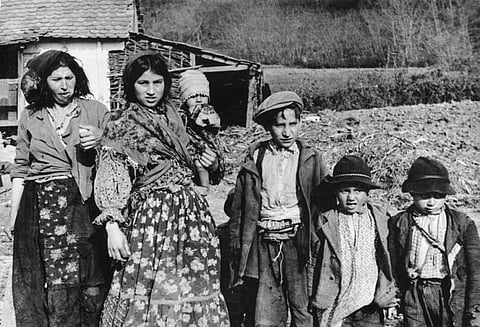
- Destinations
- Experiences
- Stay
- What's new
- Celebrating People
- Responsible Tourism
- CampaignsCampaigns
- Subscribe
- Buy Now

The Romani people, often also quipped as ‘Roma’, represent one of Europe’s most prominent of ethnic minorities. They are estimated to be a demographic of about 10 to 12 millions individuals distributed over the continent. The Roma have historically been marginalised, persecuted and subjected to discrimination, despite their substantial presence. Curiously, the Romani people are believed to have originated from northern India, more precisely, the areas that make up the modern day Rajasthan and Punjab. It is speculated that they set off on an incredible migration over a thousand years ago, and are now seen in Europe.
Various linguistic and genetic studies have established that the Roma originated from what is modern day northwestern India. Their language, Romani, shares significant similarities with Sanskrit and modern Indo-Arabic languages, underscoring their Indian origins. According to genetic study, the first migration from India took place some 1,500 years ago. From there, people moved westward through Persia (modern-day Iran), Armenia, and Turkey (now Türkiye) before arriving in southeastern Europe by the 14th century.
When the Roma arrived in Europe, they were first accepted on account of their abilities in a variety of crafts, such as carpentry, singing and metalworking. However, they soon started facing incessant mistrust and animosity as they dispersed around the continent. The Roma turned into a focus within the grip of laws in many parts of Europe by the 15th century, resulting in widespread persecution and discrimination.
The history of the Roma in Europe is tainted by institutionalised discrimination. They were enslaved in a number of places, a practice that continued into the 19th century, most notably in Romania. An estimated 5,00,000 Roma were killed in extermination camps and other locations as a result of the Nazi regime's racial policy during World War II. This sad time in Roma history is still remembered as the Porajmos, which means "devouring" in Romani.
In spite of decades of hardship, the Roma have managed to preserve a rich cultural legacy that includes lively dance, music, storytelling and handicrafts. Several European musical forms, such as jazz in Eastern Europe and flamenco in Spain, have been greatly impacted by their musical heritage in particular. The cultural manifestations of the Roma minority, including the lavish architectural styles of places like Hășdat in Romania also demonstrate their tenacity. These intricately decorated structures represent social standing and cultural pride in the neighbourhood.
The Roma still suffer many difficulties today, including poverty, social isolation and restricted access to healthcare and education. Many of them reside in remote areas with poor quality of life. Their job prospects and general quality of life are negatively impacted by the widespread discrimination that still exists. For instance, Roma people in central and eastern Europe can anticipate living 10 years less than their non-Roma counterparts.
Several international groups and national governments have launched campaigns to enhance the socioeconomic conditions in the Roma. For example, in an attempt to remove preconceptions and foster mutual understanding, the Council of Europe has been aggressively promoting the teaching of Roma history and culture. There are also efforts to commemorate the Holocaust in Rome and acknowledge their historical contributions to Europe.
Distinguishing the Roma from other nomadic tribes, such the Irish Travellers, is crucial. They have different ethnic origins, traditions, and languages, even though both groups have historically lived nomadic lives. Many members of the Roma group reject the derogatory name "Gipsy," which is frequently used to refer to them. When delegates chose a flag, anthem, and the international day on April 8, 1971, the favoured title "Roma" gained international recognition.
